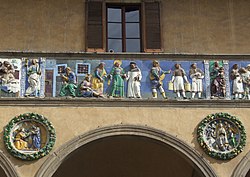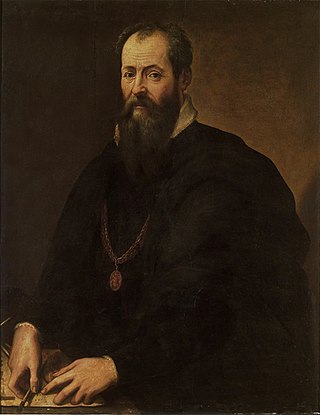
Giorgio Vasari was an Italian Renaissance painter and architect, who is best known for his work Lives of the Most Excellent Painters, Sculptors, and Architects, considered the ideological foundation of all art-historical writing, and still much cited in modern biographies of the many Italian Renaissance artists he covers, including Leonardo da Vinci and Michelangelo, although he is now regarded as including many factual errors, especially when covering artists from before he was born.
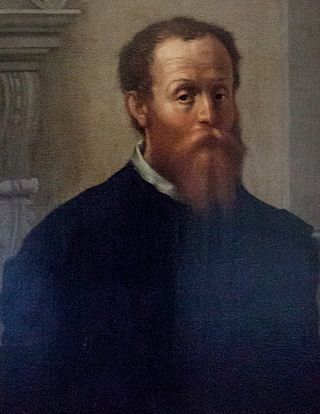
Baccio Bandinelli, was an Italian Renaissance sculptor, draughtsman, and painter.

Luca della Robbia was an Italian Renaissance sculptor from Florence. Della Robbia is noted for his colorful, tin-glazed terracotta statuary, a technique that he invented and passed on to his nephew Andrea della Robbia and great-nephews Giovanni della Robbia and Girolamo della Robbia. Although a leading sculptor in stone, after developing his technique in the early 1440s he worked primarily in terracotta. His large workshop produced both less expensive works cast from molds in multiple versions, and more expensive one-off individually modeled pieces.

Cosimo I de' Medici was the second duke of Florence from 1537 until 1569, when he became the first grand duke of Tuscany, a title he held until his death.

The Palazzo Vecchio is the town hall of Florence, Italy. It overlooks the Piazza della Signoria, which holds a copy of Michelangelo's David statue, and the gallery of statues in the adjacent Loggia dei Lanzi.

The Palazzo Pitti, in English sometimes called the Pitti Palace, is a vast, mainly Renaissance, palace in Florence, Italy. It is situated on the south side of the River Arno, a short distance from the Ponte Vecchio. The core of the present palazzo dates from 1458 and was originally the town residence of Luca Pitti, an ambitious Florentine banker.

Agnolo di Cosimo, usually known as Bronzino or Agnolo Bronzino, was an Italian Mannerist painter from Florence. His sobriquet, Bronzino, may refer to his relatively dark skin or reddish hair.

The Bargello, also known as the Palazzo del Bargello or Palazzo del Popolo, is a former barracks and prison in Florence, Italy. Since 1865, it has housed the Museo Nazionale del Bargello, a national art museum.

Stradanus, Johannes Stradanus, Jan van der Straet or Giovanni Stradano was a Flemish artist active mainly in 16th-century Florence, Italy. He was a wide-ranging talent who worked as an easel and fresco painter, designer of tapestries, draughtsman, designer of prints and pottery decorator. His subject range was varied and included history subjects, mythological scenes, allegories, landscapes, genre scenes, portraits, architectural scenes and animals. After training in his native Flanders, he left his home country and ultimately settled down in Florence, Italy. He became a prominent court artist to the Medici during the second half of the 16th century and worked on the many decorative projects of the court. Stradanus also produced large altarpieces for the most important churches in Florence.

Foiano della Chiana is a small agricultural town in eastern Tuscany, in the province of Arezzo, between the cities of Sinalunga and Cortona. It is well known for its annual carnival.
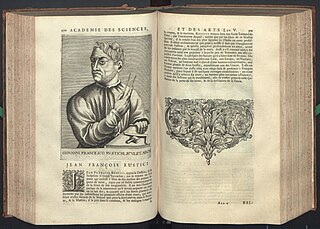
Giovan Francesco Rustici, or Giovanni Francesco Rustici, (1475–1554) was an Italian Renaissance painter and sculptor. He was born into a noble family of Florence, with an independent income. Rustici profited from study of the Medici sculpture in the garden at San Marco, and according to Giorgio Vasari, Lorenzo de' Medici placed him in the studio of Verrocchio, and that after Verrocchio's departure for Venice, he placed himself with Leonardo da Vinci, who had also trained in Verocchio's workshop. He shared lodgings with Leonardo while he was working on the bronze figures for the Florence Baptistry, for which he was ill paid and resolved, according to Vasari, not to work again on a public commission. Moreover, an echo of Leonardo's inspiration is unmistakable in the much-discussed and much-reviled wax bust of "Flora" in Berlin, ascribed to a circle of Leonardo and most probably to Rustici. At this time, Pomponius Gauricus, in De sculptura (1504), named him one of the principal sculptors of Tuscany, the peer of Benedetto da Maiano, Andrea Sansovino and Michelangelo. It may have been made in France, perhaps in the circle of Rustici, who entered Francis I's service in 1528.

Giovanni della Robbia (1469–1529) was an Italian Renaissance sculptor, mostly in ceramics.
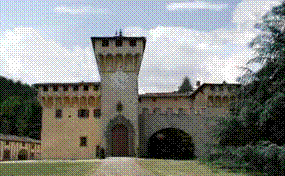
The Villa Medicea di Cafaggiolo is a villa situated near the Tuscan town of Barberino di Mugello in the valley of the River Sieve, some 25 kilometres north of Florence, central Italy. It was one of the oldest and most favoured of the Medici family estates, having been in the possession of the family since the 14th century, when it was owned by Averardo de' Medici. Averardo's son, Giovanni di Bicci de' Medici, is considered to be the founder of the Medici dynasty.

Hendrick van den Broeck or Arrigo Fiammingo was a Flemish painter, fresco painter, glass painter and sculptor of the late-Renaissance or Mannerist period. After training in Flanders, he travelled to Italy where he remained active in various cities for the remainder of his life. He was court painter to Cosimo I de Medici in Florence and worked as a fresco painter in Rome on the large decorative projects of pope Gregory XIII.

The Lives of the Most Excellent Painters, Sculptors, and Architects, often simply known as The Lives, is a series of artist biographies written by 16th-century Italian painter and architect Giorgio Vasari, which is considered "perhaps the most famous, and even today the most-read work of the older literature of art", "some of the Italian Renaissance's most influential writing on art", and "the first important book on art history".

The Villa di Castello, near the hills bordering Florence, Tuscany, central Italy, was the country residence of Cosimo I de' Medici, Grand Duke of Tuscany (1519-1574). The gardens, filled with fountains, statuary, and a grotto, became famous throughout Europe. The villa also housed some of the great art treasures of Florence, including Sandro Botticelli's Renaissance masterpieces The Birth of Venus and Primavera. The gardens of the Villa had a profound influence upon the design of the Italian Renaissance garden and the later French formal garden.

Benedetto Buglioni (1459/1460–1521) was an important Italian Renaissance sculptor specialised in glazed terracotta.

Ospedale del Ceppo is a medieval hospital founded in 1277 in Pistoia, Tuscany, central Italy.

The Palazzo Pretorio is a historical building in Prato, Tuscany, Italy. It was the old city hall, standing in front of the current Palazzo Comunale. It now accommodates the Civic Museum of Prato, which was reopened in September 2013.

Vincenzo Borghini was an Italian monk, artist, philologist, and art collector of Florence, Italy.

